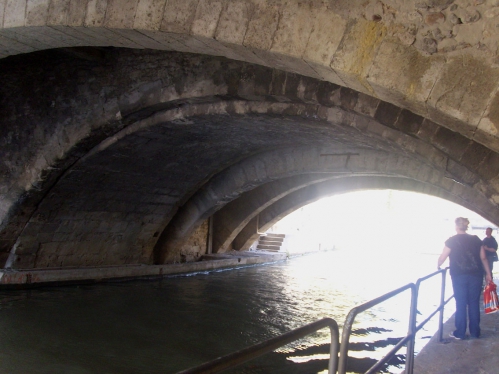VIA DOMITIA Clos de la Lombarde 2013
2013 - what a year!
The Association, Friends of the Clos de la Lombarde, only created 18 months ago, became quite active in 2013, with many ideas for events and so on. At the AGM in January, in the Salle des Synods in the cathedral complex, everyone was positive about future plans. Then we had a talk about Amphoralis, from the point of view of the archeologists, and arranged an outing there. (Click here to see Amphoralis.)
2013 was the 40th anniversary of the excavations at Clos de la Lombarde. So after the meeting we shared a New Year glass of Blanquette de Limoux to toast the Association - in the company of a statue well-known in Narbonne. He is called Silène. I liked it so much because this the model for the statue was a real man of mature years; who was it who posed 2000 years ago?

Another meeting On 2 February, we started to work towards the great weekend of 14/15 September, the Cultural Inheritance day at Narbonne. It was decided to restore the small garden belonging to the house called Grand Triclinium. 
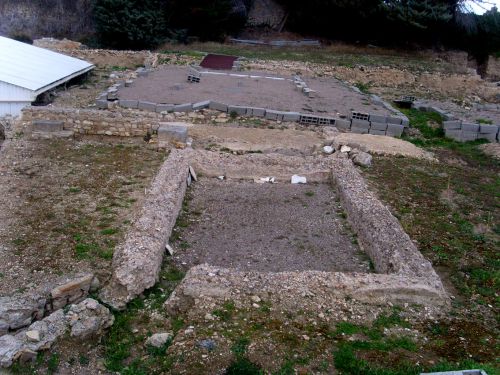
A map and a model gave a real idea of how it would work. 
We also planned many exhibitions for the big day in September, when the site of Clos de la Lombarde would be open to the public, plus an exhibition on October.
The garden was done! On an open day was held on the 8th of June and it poured with rain! 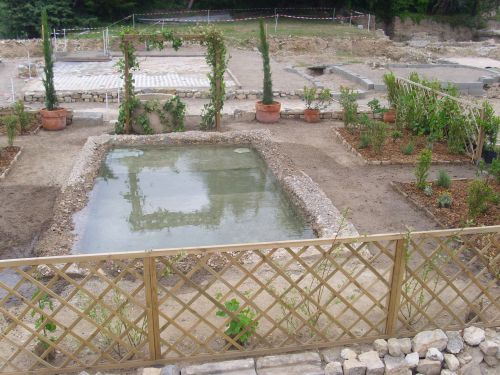
We huddled under our umbrellas. 

Mme Cathala, the councillor in charge of cultural matters from the town hall of Narbonne, gave a speech. "Never mind, the rain will be good for the garden," she said drily. And laid out under the trees, the mosaic exhibition looked a bit - sad.

But all went well on September 14! We were royally entertained during the day. We tasted various varieties of Roman wine, plus bread made to a Roman recipe.


The wine is made from Roman recipes and is organic - AND not too expensive.
You could learn how to make mosaics, I was fascinated when it was explained to me how it was done, to produce those brilliant effects with some chips of stone.
I loved the Venus and the Christ. Lean away from your screen a bit, to see them better.
The mosaic teacher, France Dodin, is well-known in the Narbonne region, and holds classes with the MJC of Narbonne. (MJC mean "Maison Jeune et Culturelle.") She runs the "Atelier Mosaique" on Monday afternoons and Saturday mornings. You can telephone her on 06 68 45 72 61


Then the actors prepared their costumes. And we watched the humorous sketch they played for us on the new Roman Garden. I made two films with the tiny camera, very amaterish, but they will give you an idea. They were talking in Latin and mentioned the name of the owner of Clos de la Lombarde - Marcus Clodius. The friends arrived - and Marcus was flirting a bit!
click here for the first part of the film . . . . . . . and here for the second.
VIA DOMITIA Clos de la Lombarde 40 years
Great October 2013
We met as usual in the Salle des Synods for a "conference" to start the celebrations of forty years of excavations at the Narbonne site called Le Clos de La Lombarde. An amateur archeologist, a schoolteacher called Raymond Sabrie, got permission to excavate the site under the umbrella of a formal archeology group and the work, with the team he collected, never stopped for forty years.
An incredible man, he was the only one with a dry eye when he gave his speech! He said: "When I was young an old Occitan man gave me some advice. Decide what you want to do with your life and then do it, with all your heart and all your strength. So that's what I did."
Then a young lady gave us a talk about the early Christian churches of France. The one at Clos de la Lombarde was built about 350AD and claims to be the very first, but there are other early Constantine, or Byzantine, churches, so called because they were among the first after Constantine ratified Roman Christianity as the state religion in 325AD. At the time Gaul was part of the Roman Empire.
The stone sepulchres were found beneath the floor of the church; this is where the important people were buried. There was also a baptismal pool.
It's known that Christianity was preached in private houses and in the open air and countryside around Narbonne from about 50AD when St. Paul Serge came to the region. Christianity was one cult among the many Roman and Celtic cults until 325AD, hence there were no church buildings.
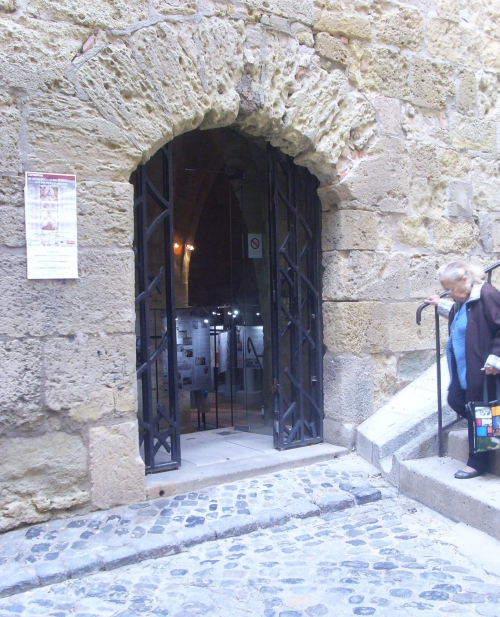
The exhibition was held in the Salle du Pilier, late 15th century, on the left before you go up the steps to the Cathedral of Narbonne.

As well as the information panels with their pictures of incredible finds, mosaics and frescos, were items reflecting the everyday life of these Roman aristocrats in Roman Narbonne.
The reconstructed mosaics and frescoes were the result of hours of painstaking work. The fragments were collected and reconstructed and can now be seen in the Archeological Museum of Narbonne. People were particularly fascinated by the design of Apollo harnessing his horses before chasing the sun. Originally, this had been painted as though the viewer was looking through the window of the villa at the scene.
The naked god who flew too close to the sun . . .
I have always been interested in the history of everyday life; here's what the ladies of the day wore.


The public came in their hundreds, it was gratifying they were so interested, I spoke to people from all over the world. The expo was open for three weeks and every other day Nicole and myself went along to lend a hand and to explain the exhibits in several languages. Well, Narbonne IS the largest town in the department of Aude and it WAS the capital of Roman Gaul for three hundred years.
VIA DOMITIA Narbonne Centre
Roman history is never far away in Narbonne! I was lunching with a friend and we found this establishment on the Rue Droite. This street, lined with small shops, continues north from the Place de Ville in front of the cathedral, where is revealed part of the Roman Via Domitia.
Before La Place, today's rue de Pont des Marchands crosses the canal, which used to be the river Aude in Roman days, and the arches of the old Roman bridge can still be seen by the water if you walk along the canal bank.
So, over the bridge, across the place, and up the rue Droite to find our eaterie, where I had great fun photographing the reflections in the window across the narrow road. Inside was preserved a beautiful Roman arch!
In Roman days, all the small shops would be set back a little from the road; this arch was actually the entrance to a shop. Basically, the small trading customs of the rue Droite have not changed since Roman times. We sat at the table on the left to enjoy a vegetarian meal at a reasonable price with salad thrown in, and admired the decor. It was not however, Roman!
The Creperie d'Oc is open at lunchtimes on weekdays.
VIA DOMITIA - Loupian
Villa de Loupian
This excavated Roman villa, plus museum and guide, is situated between the modern villa of Loupian and the étang de Thau, and is famous for its mosaics. (The Via Domitia passed it a little to the north of today's A9 autoroute.) On 3rd April 2010 I went with the Association Via Aquitana to visit this site. One is obliged to book a tour with a guide, by the way; one cannot wander around alone although, being a large group, we could detach ourselves a little to take photos.
First we saw a series of murals, which clearly showed the position of the villa, on a south-facing slope overlooking the sea. (The Romans nearly always built on a south-facing slope.)
You can see the étang de Thau as it was in Roman times, with the island on which now is Sète. The road from the villa to the sea is shown on the right of the picture. The Romans loved fish and shellfish; they would have gone to the waterside everyday to pick up supplies. You can see olives trees, vines and fields of grain, for this was a sort of self-supporting domain. Also nearby (not shown on this picture) were quarries for building stone.
In the first rooms of the museum were many glass cabinets showing scenes from everyday life - the hunters, the vine-growers, the fishermen - and a brief history of the villa, from 100BC until the early 5th century. 
Reconstruction of the villa before it was abandoned after the Visigoths came.
We had already seen a reconstruction of wine preparation, the amphores, the workers, the baths, also a model of the "chapelle paleo-chretien" of the 5th century, maybe Visigothic. 
The remains of thie chapel/church can be seen in the nearby village of Loupian, all exposed, you can walk around them, but I was in somebody else's car and they said we didn't have time to stop . . .
To see the mosaics, for which Loupian is famous, you have to cross the land behind the museum to enter a hangar, constructed to protect the mosaic floor from the weather. The guide explains everything and you have to walk along walkways to view the exhibits. You can imagine the life as it was lived by the Roman bosses. 
The mosaics were wonderful! In fact, this is what Loupian is famous for, world-wide. These were the last ones done before the villa was abandoned. The style is called Byzantine, from the second half of the fourth century. An artist came from the Near East to do it. 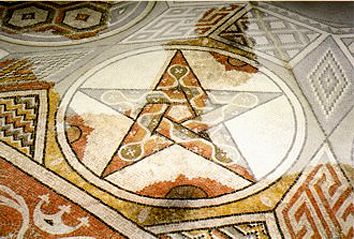

Have a look at the mosaics from the second century at La Vernède in our article - quite different. The Byzantine style is more ornamental, more florid, less real images of real people and animals.

The Syrian symbolisme is a little bit magic and typical of the period. 

The tour continued for more than two hours. nd then we went to nearby Bouziques for a sea-food lunch.
For an interesting site in English - click here
VIA AQUITANA - Nevian Villa
A South-facing villa
The route of the Via Aquitana as very close to today's RN113. The remains of the villa are 700 metres from the road - a classic situation. Like us today, the Romans didn't like to live beside main roads, with the noise of the traffic - carts, farm vehicle, chariots - and all the attendant commercial places. They liked to build on a peaceful south-facing slope a little way away.
The small remains we found confirmed that the villa existed in the first century BC. It seems it was abandoned in the times of the Visigoths (400AD to 760AD.) There was not a battle, it was simply that the new masters of Gaul were not numerous enough to have the manpower to maintain all the villas and farms.
The remains also confirmed that the villa was very rich. They had frescos on the walls, floors made of small bricks in a herring-bone pattern, and much domestic pottery, some quite fine - sigillee, sigillee Africaine, "poterie noire." A part of the wall of the villa still remains and plenty of fragments of tegulae - the large heavy roof-tiles used by the Romans - are laying on the ground. 

Back at the house, we organised our finds. 

sigillee pottery and the handles of amphores 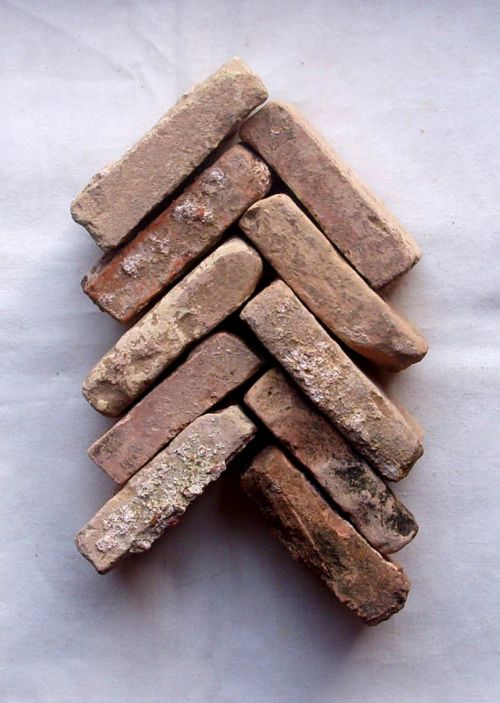


floor-bricks, bases of pottery bowls, and rims. We did not find two rims that matched, such was the variety of pottery.
A beautiful spot. Visit in spring before the vegetation hides the ground.













